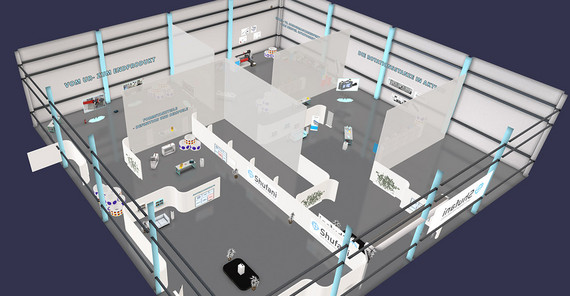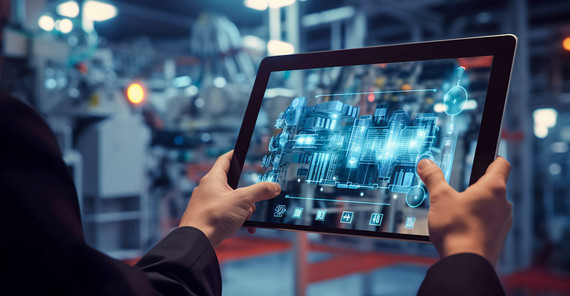Digitalization is changing the way we work, but also the ways in which we acquire knowledge – in other words, how we continue learning. In many places, this field is neglected because there are often not enough resources. What’s more, technological innovations are only being introduced relatively late, as many older employees are not very open to them - or at least are assumed not to be. Yet new educational technologies could actually be particularly helpful for people who have had longer breaks in their educational biography. After all, they enable highly individualized learning – at your own pace, with intuitive access, and tailored to your personal needs.
Creating age-appropriate virtual learning environments
“To date, older employees have often been neglected when it comes to further training,” says Malte Teichmann. “But it is particularly important for them to gain qualifications so that they can keep pace with digitalization. In addition, small and medium-sized companies often depend on the expertise of these employees and should think twice before giving up this wealth of experience due to a lack of further training programs.” Teichmann, who is a researcher at Prof. Dr. Norbert Gronau's Chair of Information Systems, has investigated, together with Jana Gonnermann and Georg Ritterbusch, what “age-appropriate, process-oriented and interactive in-company training” could look like for small and medium-sized enterprises (SMEs) in the future. They focused on VR technologies, i.e., tools that depict virtual reality and enable interaction with it. “These technologies have several advantages which, if used correctly, can greatly improve age- and needs-appropriate training,” Teichmann says. VR headsets can be used, for example, to depict crisis scenarios that would be almost impossible or extremely difficult to recreate in real life. Employees can use them to practice how to deal with such tricky situations. “Virtual learning spaces also offer great freedom. You can pursue your individual interests, work slowly, even revisit scenarios, and record the knowledge in different ways as a text, video, or podcast. Ideally, it can also be applied interactively," Teichmann says.
The researchers want to develop model solutions in their project - ideally in such a way that they can later be adapted for as many different companies as possible: for a construction company as well as for a mechanical engineering firm or a fruit-growing business, for example. A kind of modular system that contains the most important elements that VR training should include: a standardized virtual learning environment, which is also highly adaptable, and individual modules which can be created without too much effort according to the specific requirements of the companies. “We realized right from the very beginning that VR technologies offer great potential for learning processes,” Teichmann says. “But we also knew that they are not a sure-fire success. For that, all the key players need to be involved – from the field of research, technology development and, above all, practice. After all, the solutions must be geared towards the needs of the SMEs.”
This is why the researchers looked for project partners: experts in adult education and VR technology as well as companies that were willing to join them on the path towards VR further training. These included a mechanical engineering company, a construction company, and a window technology company. The digital training rooms were to be designed according to their requirements.
Since these requirements were already quite different in the three companies, the business IT specialist and his colleagues first devised a template for recording relevant knowledge content in a structured manner and transferring it to a so-called specification sheet. They also set about surveying the previously sparsely cultivated field of education with VR devices. “We invested a lot of time in the theoretical foundations, gathered the relevant literature on types and kinds of knowledge, looked at how people learn and then considered how VR tools would fit in,” Teichmann says. “Because technological innovation alone does not make good education. It is about using it in a didactically smart way.”
Prototype with learning effect
That is why the team developed an initial prototype – a virtual learning space - which was then thoroughly tested by employees of the participating companies. For example, they transferred entire production processes into the VR environment. “Working on the prototypes was an exciting and very informative time for us, even with dead ends,” he says. “It was a surprise that the test subjects told us that they didn’t want too much freedom in the learning process or learning space.” The feedback was continuously integrated into the revision of the prototype: Walls were added to give it more structure, and signs were added to name and describe individual stations. “The fact that people want more guidance and direction in their learning journey was the first important finding that we took into account in future designs,” Teichmann says. The second finding: VR technologies enable highly individualized learning, simulations can be easily repeated, podcasts can be played again, but stations can also be skipped. And the third: “In addition to the didactic framework and practical requirements, technical feasibility had always to be taken into account. We correctly assessed the possibilities of the technology. But it is still extremely challenging to fully utilize them.” Until now, the elements of a virtual learning environment have had to be programmed by developers, to a large extent by hand. A rotary machine for adhesive tape production, for example, which in turn does not help a window manufacturer. This is not yet a modular system. “But generative AI will make a lot of things easier in the coming years,” the researcher is certain.
For the pilot project, the effort was certainly worth it. “Even employees who have been working for a very long time on the machines that we recreated in VR were enthusiastic because they finally got a view of the overall process and an understanding of how they are contributing to it.” Teichmann hardly sees any limits to their use. The VR tools could be used to “tailor” a training program that familiarizes new employees or those who are changing workplaces. Knowledge could also go the other way round: People who have worked in the company for a very long time and are expected to pass on their experience could test the learning environment. Their feedback would then be used to further develop such tools.
By the way, Teichmann and his colleagues are not the only ones who are enthusiastic about the results of their pilot project. Companies are also using the modules in various capacities. The researchers have already launched a follow-up project with practice partners. “In a next step, we want to look at how different VR spaces can interact with each other and where there are potential connections to other technologies,” the researcher says.
About the project: https://lswi.de/forschung/forschungsprojekte/api-kmu
The Project
Creating age-appropriate, process-oriented, and interactive further training in SMEs by using AR technologies
Duration: 2020–2022
Participants: Jana Gonnermann, Georg Ritterbusch, Malte Teichmann
Funding: BMBF, ESF, EU
The Researchers
Jana Gonnermann is a research assistant at the Chair for Business Informatics, Processes, and Systems.
Email: jana.gonnermannuwi.uni-potsdampde
Georg Ritterbusch has been a research assistant at the Chair for Business Informatics, Processes, and Systems since 2023.
Email: georg.ritterbuschuwi.uni-potsdampde
Malte Teichmann has been a research assistant at the Chair for Business Informatics, Processes, and Systems since 2018.
Email: malte.teichmannuwi.uni-potsdampde
Further reading
Malte Teichmann, Jana Busse, Jana Gonnermann, Georg Ritterbusch, Ines Langemeyer, Norbert Gronau, Konzeption, Erstellung und Evaluation von VR-Räumen für die betriebliche Weiterbildung in KMU – Erfahrungen und Handlungsempfehlungen aus dem Forschungsprojekt API-KMU, Digitalisierung der Arbeitswelt im Mittelstand 3, 2023, https://doi.org/10.1007/978-3-662-67024-8_5
This text was published in the university magazine Portal Wissen - Eins 2024 „Bildung:digital“ (PDF).


